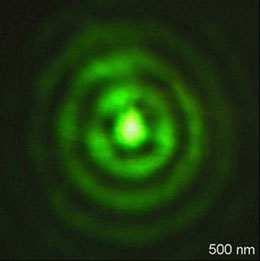New light technology could spot and help cure diseases earlier

World-leading experts at the University of St Andrews have been awarded a £5.6m grant to develop new light technologies which could improve diagnosis and treatments of diseases by being able to see into the human body in more depth and detail than ever before.
The team at the School of Physics and Astronomy at the University of St Andrews, led by Professor Kishan Dholakia, has been awarded the grant from the EPSRC worth £5.6 million.
The grant focuses on the science of photonics – the generation and application of light in its many forms – and explores a range of concepts of shaping or ‘structuring’ light at the micro and nanoscales.
Such advances with light have major potential in healthcare. Further down the line this could enable improved diagnosis of diseases, and treatments using light therapy, making a significant contribution to improved quality of life.
The methods developed would not be restricted to biomedicine, however and could be used in other industries.
The project “Challenging the Limits of Photonics: Structured Light” will also involve Professors Ifor Samuel and Thomas Krauss at St Andrews as co-investigators on the grant.
They will contribute their world renowned experience in polymer light emitting materials and photonic crystals respectively.
Prof Dholakia is a world-leading expert in optical trapping, beam shaping and biophotonics.
The ambitious goal of this new programme is to challenge and overcome current limits in the generation, propagation and penetration of light.
One of the key targets of the project is imaging through scattering media, especially biological tissue and skin, another is to achieve imaging with extremely high resolution, even at a distance.
These targets will be achieved by developing new approaches to the field of “structured light”, which sees the generation of complicated laser beam structures by using full control over the amplitude, phase and polarisation and applying these to novel sources.
New forms of sensing will be possible, whereby the ability of light to interrogate extremely small volumes of tissue or biofluids (e.g. the content of a cell) can be used to find new methods for disease detection and prevention.
Professor Dholakia said: “Our new understanding and applications of light can also impact in other areas of biology and medicine such as the emergent field of optogenetics.
“Optogenetics is the Science of controlling events in targeted cells using light alone, which has immense promise in relation to neuroscience, e.g. to understand conditions such as epilepsy and control Alzheimer’s disease”
He added: “This grant is a testament to the excellent advances made by our team in the photonics area at St Andrews in the last decade.
“We are very excited about making ground-breaking advances both in fundamental photonics and light sources but also notably with colleagues in Biology and Medicine with real impact upon emerging healthcare challenges.”
Note to Editors
Please contact press office for images.
Issued by the Press Office, University of St Andrews
Contact Fiona MacLeod on 01334 462108 / 0771 414 0559.
Ref: (light 18/04/12)
View the University’s latest news at http://www.st-andrews.ac.uk/news/
Category Research